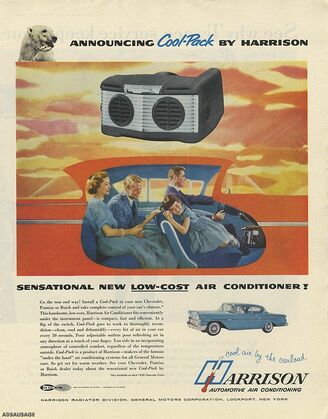 by P Sanchez In the 1900’s, the public has its first taste air-conditioned buildings, starting with the Missouri State Building in St. Louise World Fair in 1904. The building included a 1000 seat auditorium comfortably cooled by this new-fanged a/c technology. In the refrigeration front, General Electric introduced its first refrigerator compact enough for household use in 1911. Frigidaire and Kelvinator introduced their domestic refrigeration machines in 1915 and 1918 respectively. But it would be a couple more decades until the new cooling technology will be suitable enough for mobile application. Smaller. Cheaper. Cooler. Stronger.
Back to air-conditioning, In 1929, Frigidaire introduced its first a/c unit for domestic use. The split-type design kept the bulky and noisy compressor-condenser units outside of the house or building, with only the smaller evaporator unit indoors. General Electric introduced the first self-contained room cooler in 1930. At around this time, General Motors has developed a new type of refrigerant, CFC, an odorless, non-flammable, low boiling point gas that’ll make cooling and refrigeration systems safer and more efficient. By the 1930’s, the use of air-conditioning in public spaces such as stores, movie houses and theaters, was already much established and getting air-conditioning to cars was a logical next step. Around this period, a home refrigerator manufacturing company, C&C Kelvinator outfitted the trunk of a Cadillac of a Texas client with a 1.1 kW gasoline-engine powered refrigeration unit. Air from the cabin is piped to the refrigeration unit with fans and cooled air is circulated back. The device provided the aftermarket air-conditioning retro-fit standard during the 30’s. The 40’s saw the first cars with built-in air-conditioning but they were only available as expensive luxury options. First introduced by Packard, the technology involved the compressor powered directly by the engine. The compressed refrigerant was cooled by a condenser situated in front of the radiator (much like how it is in modern cars). The refrigerant is then pumped to the back of the vehicle, travelling via long tubes, and finds the evaporation coils right behind the back seats. Blowers draw air from the cabin to the cooling coils and expel back cooled air. The design was obviously meant to be enjoyed by the chuffeur-driven bourgeois but it was still not without its shortcomings. High cost aside, the setup created uneven cooling in the interior. Water condensation also seeped through the backseat, often damping the passenger’s clothes. Up to the 1950’s, aftermarket a/c installations and other cooling implements became more popular because of better design and relative affordability. In the 50’s, major car manufacturers like General Motors, Chrysler and Packard have come up with more factory-installed practical systems. Oldsmobile came up with a design that allowed both heating and cooling with uncomplicated controls. Though these systems were more reliable and cost less than their predecessors, they still cost around a quarter of total value of the car, as such they were still regarded as luxury options. The 60’s brought better production methods and the economies of scale have allowed air-conditioning to trickle down as options to mid-priced cars. Ford was even able to provide the option for its Facon and Comet model at only 10% of the price of the car. Other manufactures were also able to drive down prices. By the end of the decade, almost 60% of the cars produced had factory-installed air-conditioning. The 70’s heralded more refinements made to automotive a/c that brought more compact, efficient and affordable designs. Entire units were 80% lighter, with compressors smaller than a shoe box that gave 10 times more cooling power than designs of the previous decades. As such, market penetration of a/c reached 70% by the end of the decade. Up to this point, all auto a/c systems used chloroflourocarbon based refrigerant named R12 which has been found to be destructive on the atmospheres’ ozone layer. Testing of environmentally safer refrigerant like R134a started, spearheaded by Harrison Radiator and Allied Chemicals. The Montreal Protocol of the 80’s marked the phase-out of CFC R12 and the start of the industry-wide adoption of R134a. The 90’s marked not only the full ban of R12 but also the development of materials, parts, and lubricants that can work with the new refrigerant in cooling systems such that of automobiles. By this decade we saw 94% of all new cars come with a/c as standard. References: The Evolution of Automotive Air-Conditioning, M.S. Bhatti, ASHRAE Journal History of Air Conditioning, US Department of Energy History of Refrigeration, Lesson 1, Version 1 ME, IIT Kharagpur
0 Comments
Leave a Reply. |
AuthorSmith's Auto Repair serves Dayton, Ohio and the surrounding communities using digital inspection service for all its customers ArchivesCategories |
 RSS Feed
RSS Feed